

Terrorism’s Fertile Ground. Photo NAIROBI, Kenya — Terrorism is a global reality, and for me as a Kenyan, this struck close to home in September with the siege of the Westgate mall.
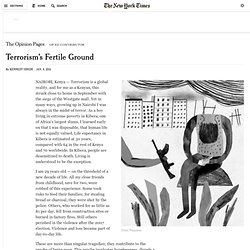
Yet in many ways, growing up in Nairobi I was always in the midst of terror. As a boy living in extreme poverty in Kibera, one of Africa’s largest slums, I learned early on that I was disposable, that human life is not equally valued. Life expectancy in Kibera is estimated at 30 years, compared with 64 in the rest of Kenya and 70 worldwide. In Kibera, people are desensitized to death. I am 29 years old — on the threshold of a new decade of life. These are more than singular tragedies; they contribute to the psyche of being poor. This, perhaps, is terrorism’s fertile ground. An environment in which you cannot get a job despite ability, ambition and persistence fosters anger. Something broke in James. News reports inform us that Kenya’s slums are ripe for terrorist recruitment. The state of al-Qaeda: The unquenchable fire. US Government “Protection” of Al-Qaeda Terrorists and the US-Saudi “Black Hole” For almost two centuries American government, though always imperfect, was also a model for the world of limited government, having evolved a system of restraints on executive power through its constitutional arrangement of checks and balances.
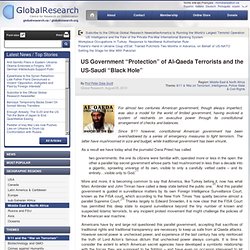
Since 9/11 however, constitutional American government has been overshadowed by a series of emergency measures to fight terrorism. The latter have mushroomed in size and budget, while traditional government has been shrunk. As a result we have today what the journalist Dana Priest has called two governments: the one its citizens were familiar with, operated more or less in the open: the other a parallel top secret government whose parts had mushroomed in less than a decade into a gigantic, sprawling universe of its own, visible to only a carefully vetted cadre – and its entirety…visible only to God.[1] “Intervened to let al-Qaeda terrorists proceed with their plots”?
Pocket : Terrorismes, guérillas, stratégie et autres activités humaines. Leveraging History in AQIM Communications. Al-Qa`ida in the Islamic Maghreb (AQIM), formerly known as the Salafist Group for Preaching and Combat (GSPC), is one of the most active al-Qa`ida affiliate organizations.
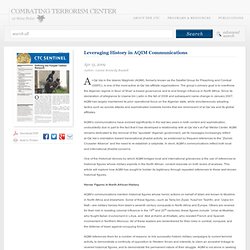
The group’s primary goal is to overthrow the Algerian regime in favor of Shari`a-based governance and to end foreign influence in North Africa. Since its declaration of allegiance to Usama bin Ladin in the fall of 2006 and subsequent name change in January 2007, AQIM has largely maintained its prior operational focus on the Algerian state, while simultaneously adopting tactics such as suicide attacks and sophisticated roadside bombs that are reminiscent of al-Qa`ida and its global affiliates. AQIM’s communications have evolved significantly in the last two years in both content and sophistication, undoubtedly due in part to the fact that it has developed a relationship with al-Qa`ida’s al-Fajr Media Center.
Heroic Figures in North African History Leveraging the Appeal of Historical Heroes Conclusion Notes [1] C.R. Al Qaeda’s Franchises after Osama Bin Laden. April 17, 2014 By Irena Chalupa and James Rupert The United States should provide military aid to Ukraine but should understand that the strength it lends the government in Kyiv will be more political than military, at least in the short run, says Former Undersecretary of Defense Walter Slocombe.
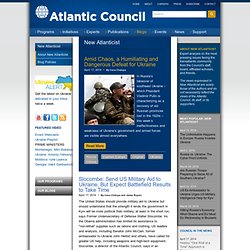
As the Obama administration has limited its assistance to "non-lethal" supplies such as rations and clothing, US leaders and analysts, including Senator John McCain, former ambassador to Ukraine John Herbst and others, have called for greater US help, including weapons and high-tech equipment. Slocombe, a director of the Atlantic Council, says in an interview that US officials "ought to be realistic," noting that provision of sophisticated systems also will require training – and therefore a passage of time – to be militarily effective. The privatisation of jihad. Mapping Militant Organizations.
Online project maps militant groups. STANFORD (US) —A new online mapping project clarifies the complex relationships among terrorist organizations around the world.

What’s the difference between Hamas in Iraq, the Islamic Army in Iraq, and the Jihad and Reform Front? The three militant Islamist groups are based in Iraq, but they have different historical roots and leadership structures. And their goals and strategies do not necessarily align, say researchers at Stanford University. 11 Years After 9/11, the Holy World War Is Over and All Jihad is Local. On the 11th anniversary of 9/11, it is some consolation that the man most responsible for that terrible morning will not be smiling smugly to himself as satellite TV brings to the leafy boulevards of Abbottabad the somber images of New Yorkers commemorating those who perished in the Twin Towers.
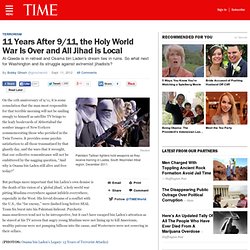
It provides some psychic satisfaction to all those traumatized by that ghastly day, and the wars that it wrought, that our collective remembrance will not be embittered by the nagging question, “And why is Osama bin Laden still alive and free today?” But perhaps more important that bin Laden’s own demise is the death of his vision of a ‘global jihad,’ a holy world war pitting Muslims everywhere against infidels everywhere, especially in the West. His fervid dreams of a conflict with the U.S., the “far enemy,” were dashed long before SEAL Team Six burst into his Pakistani hideout.
(PHOTOS: Osama bin Laden’s Legacy: 13 Years of Terrorist Attacks)